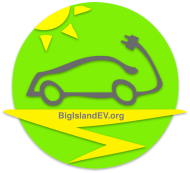We had an idea a long time ago, near the founding of the association of “bar hopping” or doing Island bar charts… Meaning that we adorn a map of Hawaii with bar charts each direction all along travel routes. It takes experience to know that going down the hill from Waimea to Kawaihae generates 30KW * 20 min = 10KWHr of energy (half a bar?) and going up the hill takes 5 bars. If everyone wants to share their bar chart experiences I can add a map to http://evhawaii.org with bar charts. Ease that thrill of range fright!. Check it out here.
My 2011 LEAF consumes between 7.5 and 9.5 bars from Hilo to Volcano. The former is very conservative driving; the latter is cruise control at the upper speed limit. (The LEAF’s goodness meter–left of speedo–hates cruise control worse that AC, for good reason, I think: power jerks up and down excessively to precisely control speed.) Volcano to Hilo consumes between 0.5 and 1.3 bars.
I don’t have enough experience on any other significant hills of general interest. Caution: results affected by wind*, rain, tire pressure, and of course speed.
* I was disappointed to find that my ride from Waimea to Hakalau (after charging at your place–thanks again) cost several bars, despite a drop in elevation of 2500 ft or so. 55 mph plus headwinds were the culprits.
For those inclined, I find that U = m g h / e provides a decent estimate of the effect of climbing a hill, where
U is the supplemental energy consumption from the change in elevation
m is the mass of the car (wet)
g is the acceleration of gravity
h is the increase in elevation
e is the efficiency of the batteries and drivetrain (I use 85%!!! Compare that to an ICE!!!)
Note: e is a decreasing function of power rate. Rapid charge or discharge will lower it. 85% applies no more than 3 dots lit up, my usual driving condition. No more than 2 dots: 90%. Four or five dots: 70-80%.
I usually figure that I can recover about fU going down.
where f =
0.7 two dots or less both up and down
0.6 three dots or less
0.5 four dots or less
0.4 five dots or less
The Tesla does give me statistics on Watt Hours/ mile which I am steady at 293 or 3.4 miles/KwH. (The Tesla is way less affected by hills and heavy foot like the Leaf.)
This is an incredible statistic if one is designing a solar system.
Check out the Bar hopping map in the resources section
